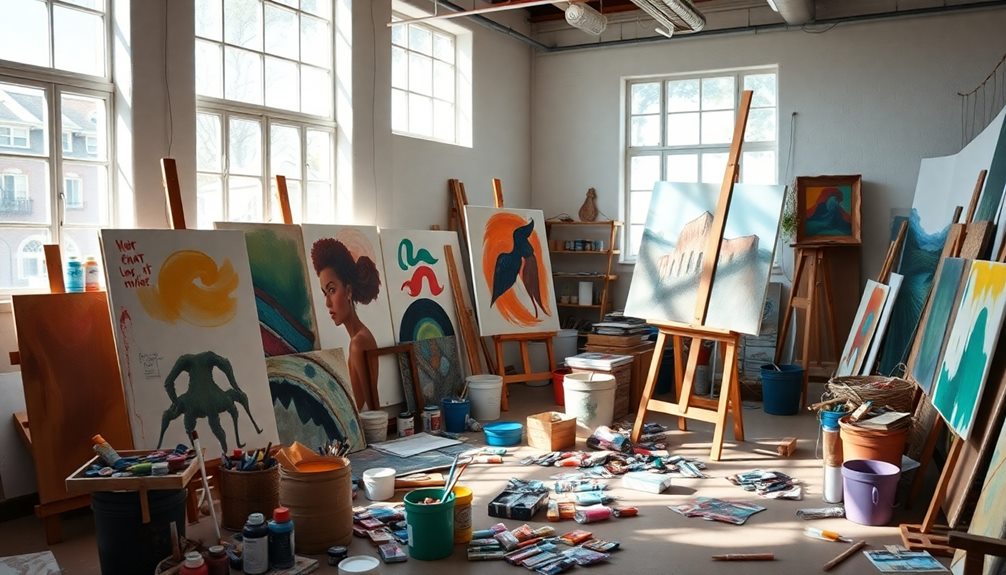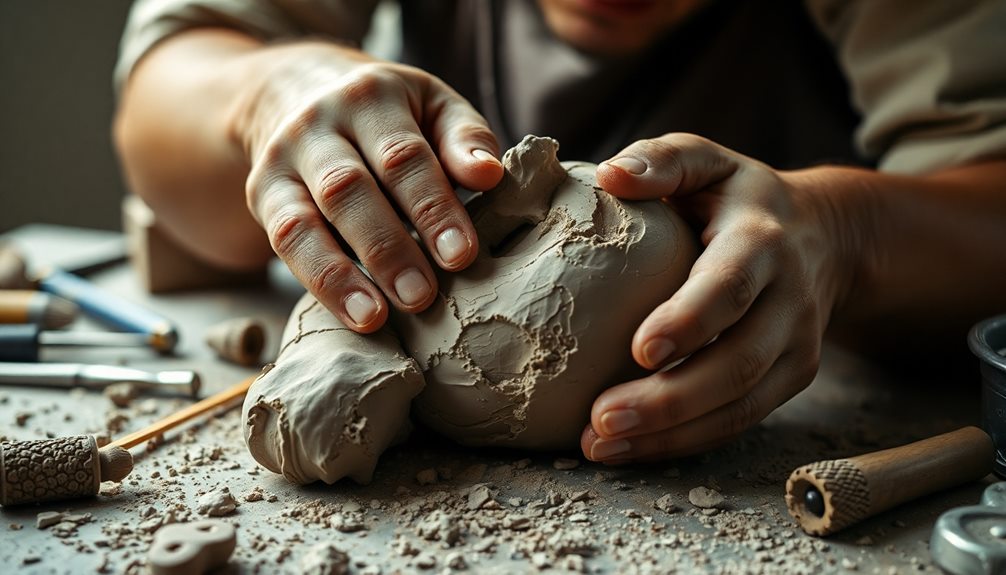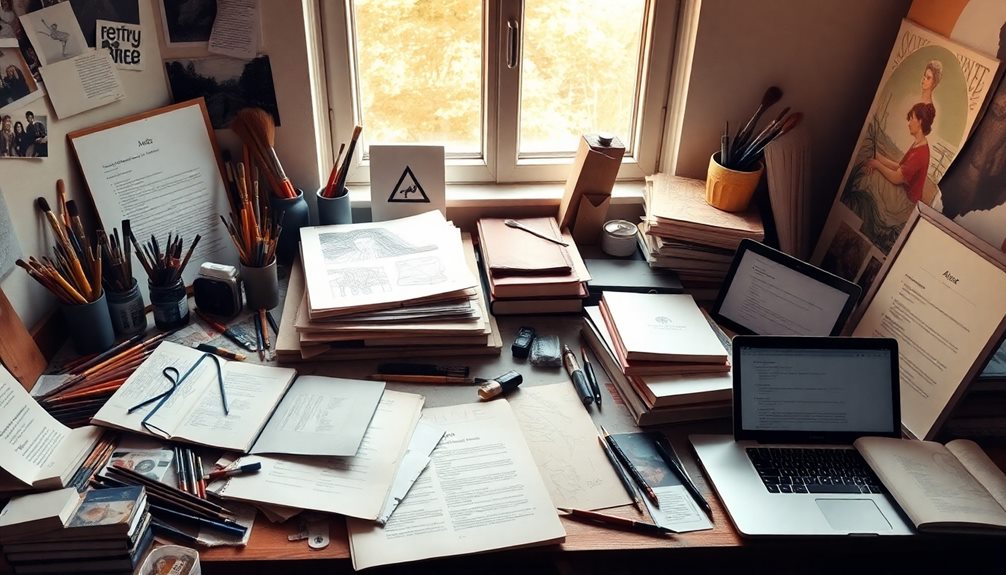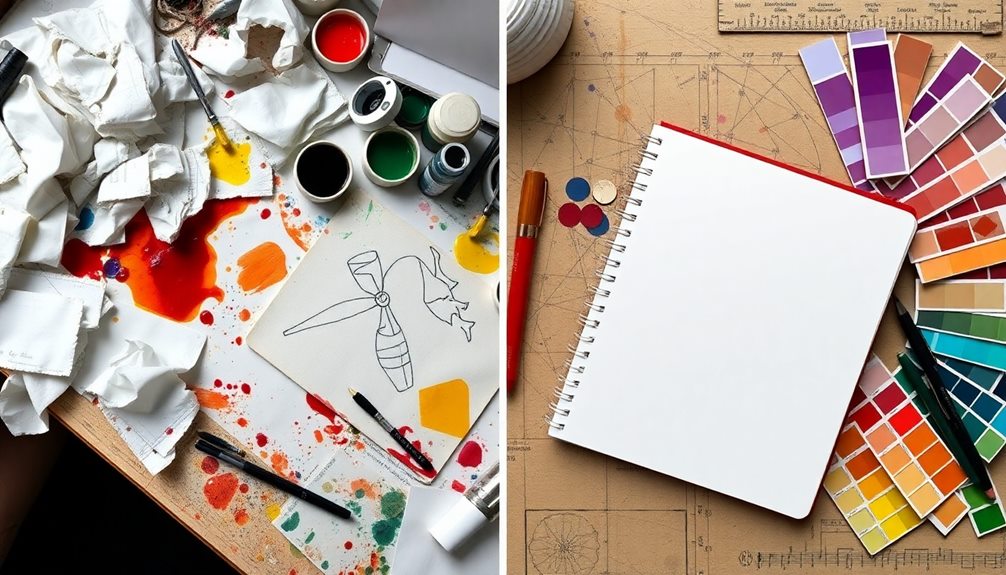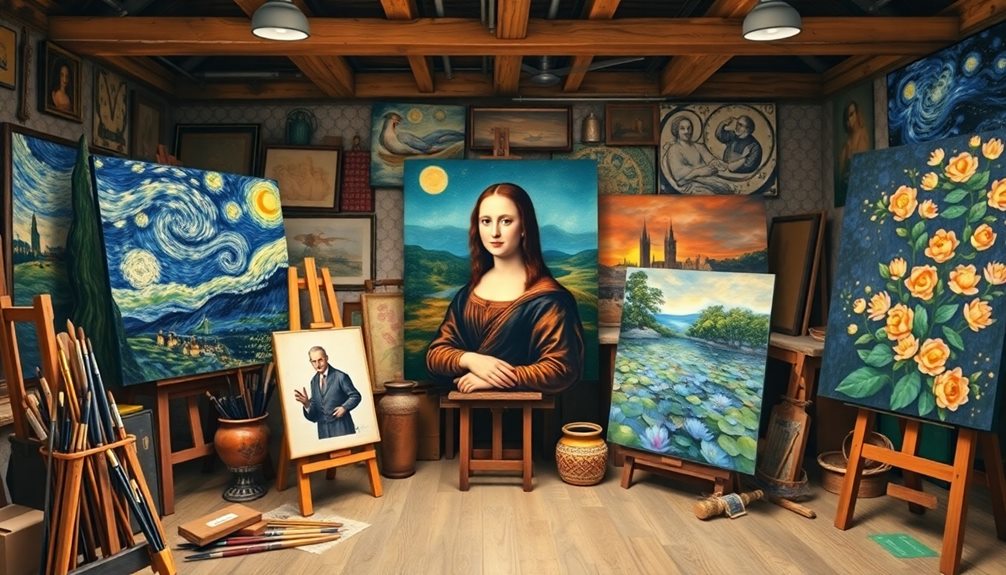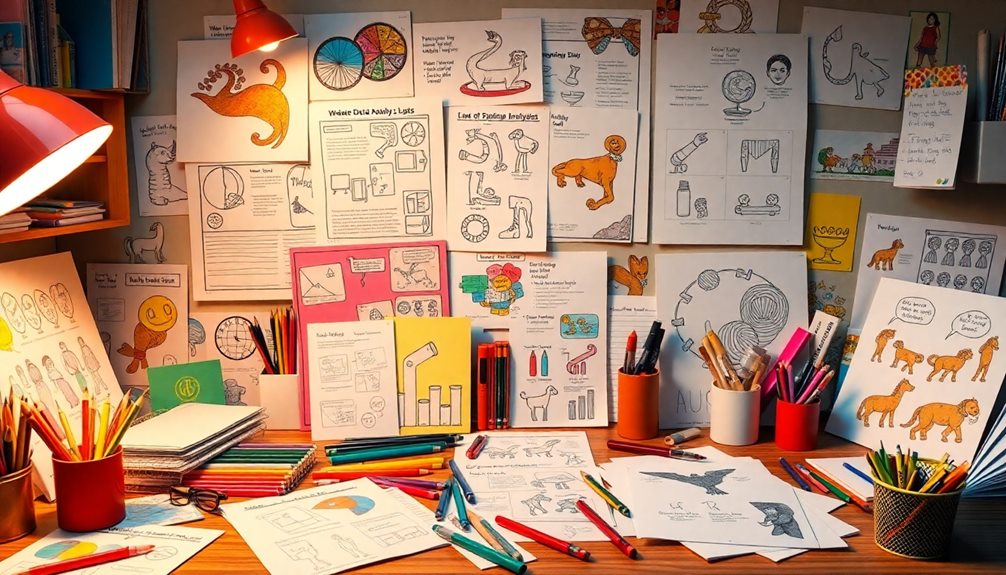When you're writing about paintings, using precise vocabulary is key to conveying your observations effectively. Terms like "palette," "composition," and "medium" help articulate essential aspects of the artwork. Descriptive adjectives such as "vibrant" or "melancholic" evoke the painting's mood, enhancing emotional connection. Pay attention to color choices, as warm tones can energize while cool hues create calmness. Understanding the artist's intent and historical context enriches your analysis. By weaving these elements together, you can create a vivid narrative. Keep exploring to discover even more techniques for enhancing your art descriptions.
Key Takeaways
- Use descriptive language to enhance observations and evoke emotional responses while discussing paintings.
- Familiarize yourself with key terms such as "composition," "palette," and "medium" for accurate analysis.
- Analyze color choices to explore emotional impacts, using terms like "warm," "cool," and "saturation."
- Incorporate artist's background and cultural context to enrich interpretation and understanding of the artwork.
- Engage with dynamic descriptions and impactful adjectives to create vivid imagery in your writing about art.
Introduction
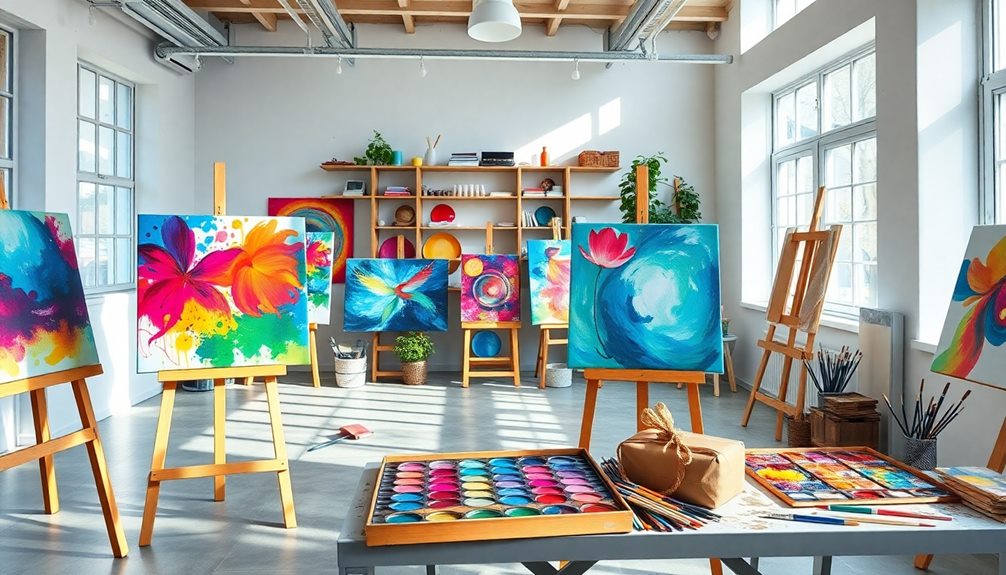
When you look at a painting, how do you begin to capture its essence in words? You start by analyzing the visual elements, using specific vocabulary to convey what you see. Descriptive language becomes your tool, helping you articulate the artist's choices in color, texture, and composition. Key terms like "palette," "hue," and "composition" not only enhance your observations but also deepen the reader's understanding of the artwork.
Consider the context of the painting, including the artist's background and the art movement it belongs to. This knowledge adds layers to your description, revealing how historical influences shape the work.
As you write, think about the mood and atmosphere the artist creates. Words like "vibrant," "somber," or "energetic" evoke emotions and draw the reader closer to the piece.
To convey underlying messages, employ techniques such as symbolism, narrative, and imagery. These elements enrich your writing, allowing you to express not just what you see, but also what the painting communicates.
Key Concepts and Definitions
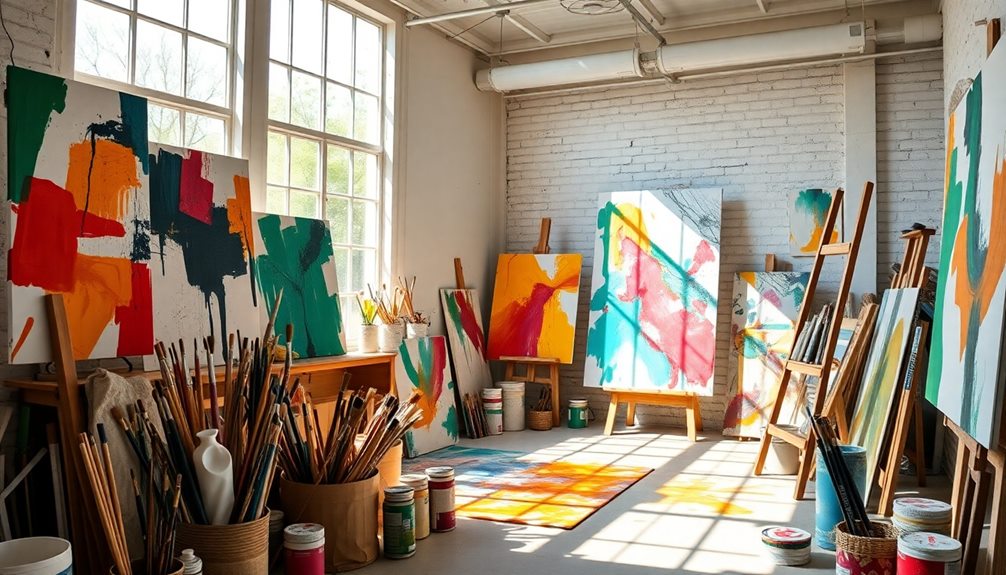
Understanding key concepts and definitions is crucial for effectively discussing paintings. Familiarizing yourself with the Elements of Art can enhance your analysis and appreciation of any artwork.
First, consider the medium; this refers to the materials used, like oil, acrylic, or watercolor. Each medium offers unique textures and effects that can significantly impact the painting's overall feel.
Next, look at the composition, which describes how the elements are arranged within the artwork. This arrangement influences balance and guides your eye to focal points.
The palette is another important element, indicating the range of colors chosen by the artist. The colors can evoke various moods and atmospheres, shaping your emotional response to the piece.
Additionally, the subject matter highlights the main theme or focus, whether it's a landscape, portrait, or abstraction.
Lastly, observe the technique; this encompasses the methods and skills the artist uses, like brushwork or layering, to create expressive effects.
Analyzing Color Choices
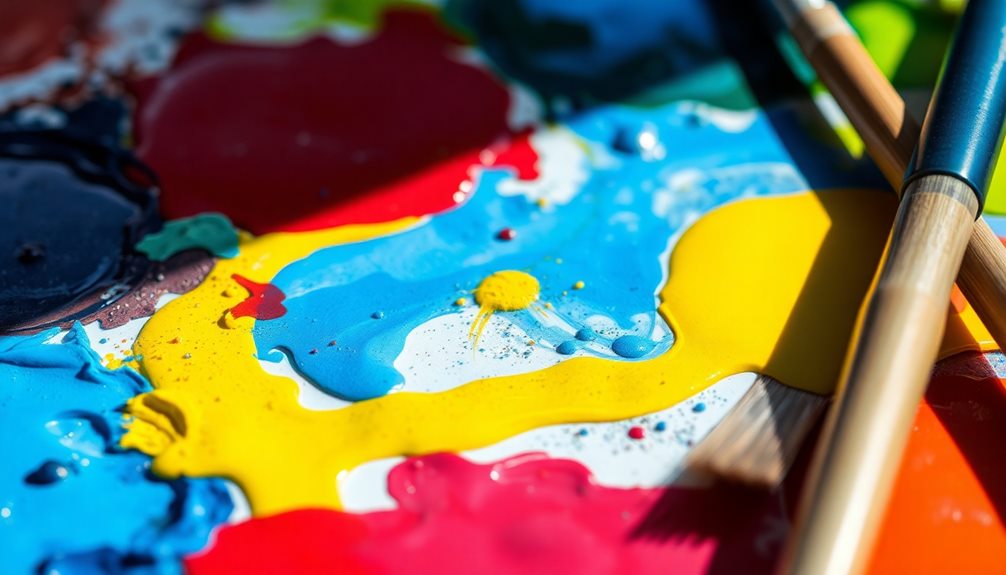
Color choices are pivotal in painting, influencing the viewer's emotional response and the overall atmosphere of the artwork. When you analyze color choices, consider how warm colors like red and yellow can evoke energy and excitement, while cool colors such as blue and green often create a sense of calm and tranquility. This emotional connection can significantly impact how you perceive the piece.
Look for complementary colors—those opposite each other on the color wheel. These can create visual tension and draw your attention to specific focal points within the painting. Alternatively, artists may use analogous colors, which sit next to each other on the wheel, to establish harmony and unity, resulting in a more cohesive visual experience.
Don't forget about the intensity or saturation of colors, as this can alter your perception dramatically. High-intensity colors appear vibrant and lively, while low-intensity colors might convey dullness or somberness.
Famous Artworks Analysis
Analyzing famous artworks allows you to uncover deeper meanings and the artist's intent behind each piece.
Take Vincent van Gogh's "The Starry Night," for instance. The swirling patterns and vibrant colors used capture his emotional response to the night sky, reflecting his internal turmoil.
Similarly, Pablo Picasso's "Guernica" serves as a powerful political statement against war, using a monochromatic palette to convey the tragedy of the Spanish Civil War.
In contrast, Salvador Dalí's "The Persistence of Memory" introduces surrealism with its dreamlike landscape and melting clocks, symbolizing the fluidity of time. You can see how time is portrayed as something that bends and shifts rather than a fixed entity.
Claude Monet's "Water Lilies" series, painted over three decades, emphasizes nature's beauty through soft brush strokes and a harmonious color palette, focusing on light and reflection.
Lastly, Leonardo da Vinci's "The Last Supper" exemplifies Renaissance art with its masterful use of perspective and composition, showcasing the emotional expressions of its figures.
Each artwork you analyze reveals layers of meaning, enriching your understanding of art history.
Tips and Best Practices
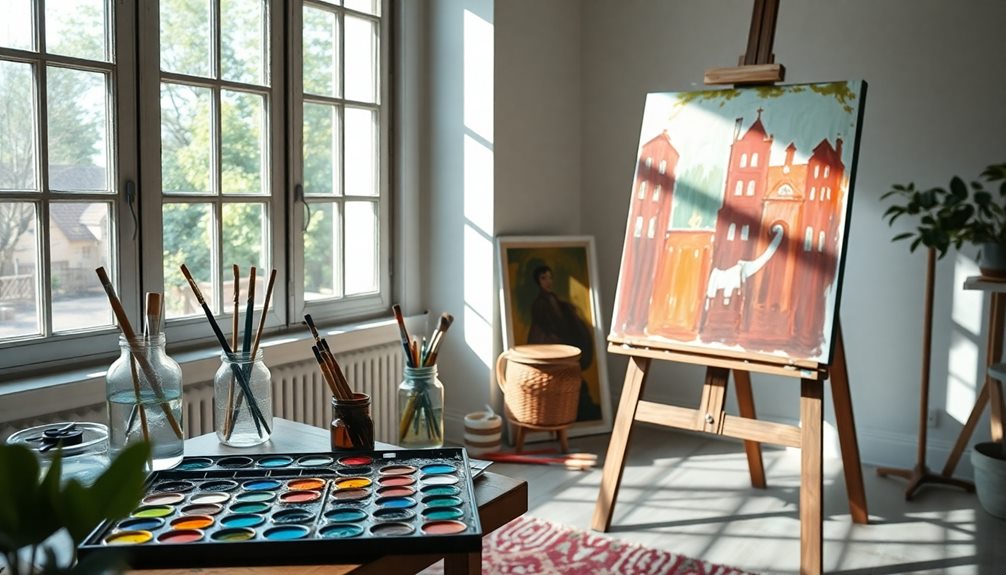
When you write about paintings, employing specific language can significantly enhance your analysis. Start by using descriptive adjectives to convey the emotional impact of the artwork. Words like "vibrant," "melancholic," or "serene" create a vivid picture in your reader's mind.
Incorporate specific art vocabulary, such as "composition," "palette," and "texture," to accurately discuss the different styles and elements that contribute to the overall effect.
Don't shy away from using present participles for dynamic descriptions. Phrases like "the waves crashing" or "the figures dancing" help convey movement and action within the painting.
When analyzing color and light, address how these elements affect the mood and atmosphere. For instance, you might say, "The warm colors evoke a sense of comfort and joy."
Audience Engagement and Feedback
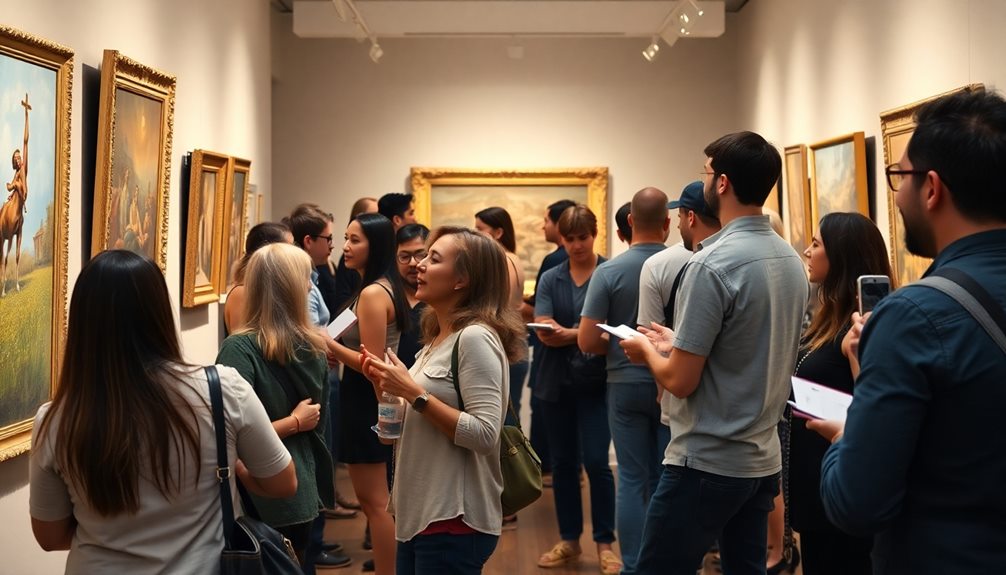
Engaging your audience effectively can transform their experience of a painting, deepening their appreciation and prompting them to share their thoughts and emotions.
By fostering audience engagement, you create opportunities for viewers to connect personally with the artwork. Encourage them to express their feelings, whether through discussions or interactive elements like Q&A sessions. This dialogue not only enriches their understanding but also cultivates a sense of community among viewers.
Gathering feedback is equally essential. Use surveys or casual conversations to collect insights about how your work is perceived.
This information can guide your future artistic endeavors and help you refine your approach. When you know what resonates with your audience, you can create more impactful experiences.
Cultural Context Impacts Interpretation

Cultural context profoundly shapes how you interpret a painting, as it encapsulates the values, beliefs, and historical events of the time in which the artist created it. When you examine a work of art, consider how the cultural context influences its themes, symbols, and subject matter.
For instance, different cultures may view colors and symbols in unique ways, leading to varied emotional responses and meanings derived from the same artwork.
Understanding the artist's cultural background can provide deeper insights into their motivations, techniques, and the messages they aim to convey. Art movements like Impressionism or Surrealism often arise in response to cultural shifts, affecting how artists approach their subjects and utilize techniques.
Moreover, historical events—like wars or social movements—can shape the narrative within a painting. These events often serve as a backdrop, showcasing the artist's commentary on their environment and reflecting the zeitgeist of their era.
Additional Resources

To enhance your understanding and appreciation of paintings, various resources are readily available to you. Online platforms like Khan Academy and Coursera offer free courses on art appreciation, diving into visual elements and analysis techniques. These courses can significantly improve your vocabulary for discussing art history.
Art history books are another great resource, providing context for different movements and styles. They help you grasp the significance of specific paintings and the artists behind them.
Additionally, museums and galleries often host workshops and guided tours focused on interpreting artworks, which can sharpen your descriptive skills.
Websites like The Art Story and Artsy are treasure troves of information. They provide artist biographies, artwork descriptions, and critical essays that enrich your understanding of paintings and their contexts.
Frequently Asked Questions
How Do You Describe a Painting in Writing?
To describe a painting in writing, focus on its composition and colors, discuss textures and size, and convey your emotional response. This approach helps readers visualize the artwork and feel its impact.
What Vocabulary Is Related to Paint?
When discussing paint, you'll encounter terms like pigments, primary colors, hue, saturation, texture, and finish types. Each word captures important aspects, helping you understand how colors and textures shape the overall appearance of artworks.
What Is the Word for Writing About Art?
The word for writing about art is "art criticism." It involves evaluating and interpreting artworks, focusing on aspects like composition, technique, and emotional impact to convey your insights and engage readers with the artist's intentions. Art criticism can serve as a bridge between the artist and the audience, translating visual elements into language that helps others appreciate the depth of the work. One effective way to deepen this understanding is to compare two artworks in writing, highlighting their similarities and differences in style, subject matter, or cultural context. This practice not only sharpens analytical skills but also fosters a greater appreciation for the diversity and richness of artistic expression.
What Are Painting Terminologies?
When you explore painting terminologies, you'll encounter terms like medium, composition, palette, brushwork, and focal point. Each term helps you understand the techniques and elements that contribute to the artwork's overall impact and meaning.
Conclusion
In conclusion, using the right vocabulary can transform how you discuss paintings. By understanding key concepts and analyzing color choices, you'll deepen your appreciation for art. Engaging with famous artworks and considering cultural contexts can enrich your interpretations. Remember to practice and seek feedback to enhance your writing skills. With these tools, you'll express your insights more vividly and connect with your audience on a deeper level. Enjoy exploring the world of art through your words!
